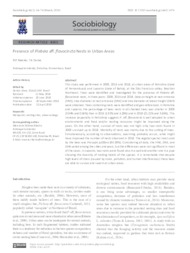Presence of Plebeia aff. flavocincta nests in urban areas.
Presence of Plebeia aff. flavocincta nests in urban areas.
Author(s): RIBEIRO, M. de F.; TAURA, T. A.
Summary: This study was performed in 2009, 2015 and 2018, at urban areas of Petrolina (state of Pernambuco) and Juazeiro (state of Bahia), at the São Francisco valley, Brazilian Northeast. Trees were identified and investigated for the presence of Plebeia aff. flavocincta nests, in three years: 2009, 2015 and 2018. Data on height at nest entrance (HNE), tree diameter at nest entrance (DNE) and tree diameter at breast height (DBH) were obtained. Trees containing nests were identified and geo-referenced. In Petrolina and Juazeiro, the percentage of bees nests in all checked trees was smaller in 2009 (3.94% and 0.56%) than in 2015 (1.92% and 5.26%) and in 2018 (21.21% and 3.66%). This increase (especially in Petrolina) suggests P. aff. flavocincta is well adapted to urban environments and food and/or nesting resources might be improved along the years. On the other hand, survival of nests was not high: only two nests found in 2009 survived up to 2018. Mortality of nests was mainly due to the cutting of trees. Simultaneously, according to observations, swarming probably occurs, what might have improved the number of nests observed in 2018. The vegetal species most used by the bees was Prosopis juliflora (84.38%). Considering all data, the HNE, DNE, and DHB varied among the cities and years, but the differences were not significant in most of the cases. In Juazeiro, two nests were found also in a wall and another one in a pipe showing the diversity of nesting habits of the species. It is remarkable that despite high levels of stress (caused by noise, pollution, and human interferences) these bees are able to survive and swarm at urban areas.
Publication year: 2019
Types of publication: Journal article
Unit: Embrapa Semi-arid Region
Keywords: Abelha, Flavocincta, Inseto, Plebeia, Prosopis Juliflora, Urban areas
Observation
Some of Embrapa's publications are published as ePub files. To read them, use or download one of the following free software options to your computer or mobile device. Android: Google Play Books; IOS: iBooks; Windows and Linux: Calibre.
Access other publications
Access the Agricultural Research Database (BDPA) to consult Embrapa's full library collection and records.
Visit Embrapa Bookstore to purchase books and other publications sold by Embrapa.

